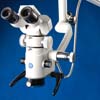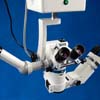The Most Important Micro Organisms Having Etiological Relationship To Ocular Diseases
The Most Important Micro Organisms Having Etiological Relationship To Ocular DiseasesBy G. E. DE SCHWEINITZ, A. M., M. D.,
OF PHILADELPHIA, PA.
THE normal conjunctiva always contains bacteria, no less than ten or twelve varieties having been isolated. If these organisms have pathogenic characteristics they are very slight (Randolph) ; indeed, it is probable that only two or three varieties should be classified as at all pathogenic (Weeks). Non pathogenic conjunctival bacteria, however, may become harmful if the tissues in which they exist are bruised or irritated (Randolph).
Pathogenic bacteria, especially those related to suppuration, are frequently found along the ciliary margins and in the secretion of the lachrymo nasal passages.
The etiological relationship of micro organisms to various ocular affections has been fully described, especially in the articles on Diseases of the Conjunctiva, Diseases of the Cornea, and Sympatlietic Ophthalmitis. For the convenience of the student a brief description of these organisms, together with the stains by which they may be recognized, is here inserted.
Koch Weeks' Bacillus. Accordill' to Weeks, this bacillus resembles that of mouse septicemia in form, and measures 1 to 2 u in length and about 0.25 u in thickness. It is often associated with a clubbed bacillus (pseudo diphtheritic or xerosis bacillus). It stains readily with ordinary anilin dyes, and may easily be demonstrated in the secretion of affected eyes. (See Plate 2, Fig. 111.)
As reagents Weeks uses methylene blue, basic fuchsin, or gentian violet.
This bacillus has been found by Weeks, Morax, Beach, and others to be the etiological factor in acute contagious conjunctivitis, as it is fully described on page 276.
Pneumococcus (Diplococcus pneumonice (Weichselbaum); Micrococcus, Pasteuri (Sternberg); Micrococcus lanceolatus (Talamon); Frankel's pneumococcus). This organism appears in the form of oval cocci each about 1 u in its longest diameter. The cocci are often arranged in pairs (hence the name diplococci), and sometimes in chains of three to ten elements: The free ends of the cocci may be pointed (hence the name diplococcus lanceolatus), and they are often surrounded by a capsule (hence the term capsulated diplococcus). (See Plate 2, Fig. IV.) The organism stains with the ordinary anilin dyes, and also bv Gram's method.
Pneumococci were first described as a cause of acute conjunctivitis by Morax and Parinaud, who supposed the disease was peculiar to early childhood. The later investigations of Gasperini, Harold Gifford, and others show that the affection is distinctly contagious, may attack adults, may be transferred from one eye to another, and may originate acute inflammation of the conjunctiva, clinically very difficult to differentiate from the Koch Weeks' bacillus conjunctivitis (see also pages 275, 276).
According to the researches of Uhthoff and Axenfeld, which have been abundantly confirmed, pneumococci are the most important etiological factors in true serpiginous ulceration of the cornea (see page 314). They are also one of the causes of panophthalmitis.
Gonococcus (Gonococcus of Neisser Micrococcus gonorrhea; Merismopedia gonorrhea). This organism is found in gonorrheal pus, in the form of a micrococcus about 0.7 u in its long and 0.5 IL in its short diameter. It often occurs in a diplococcus and sometimes in a tetrococcus form, the individual cocci being ovoid in shape, with their opposing surfaces flattened or slightly concave. The organism appears in characteristic groups within the leukocytes. (See Plate 2, Fig. II.; also Figs. 187 and 188). Gonococci stain readily with watery solutions of the basic anilin dyes e. g. methylene blue, fuchsin, etc. but are decolorized by Gram's method.
They are the etiological factor in gonorrheal conjunctivitis and in severe cases of conjunctivitis neonatorum. (see pages 278, 281).
Klebs Loffler Bacillus (Bacillus diphtherie Loffler's bacillus). This organism occurs in diphtheritic products as a slender bacillus, with round, occasionally distinctly clubbed ends, about 3 u in length. The bacilli may be irregularly scattered, may appear in clusters, or may assume a parallel grouping; often two bacilli are joined end to end (see Fig. 190). The organism stains readily with the ordinary anilin dyes, by Gram's method, and, best of all, with loffler's methylene blue. It is the cause of diphtheritic conjunctivitis (see page 284).
The pseudo diphtheritic bacillus morphologically closely resembles the virulent bacillus diphtheria, but is not fatal to animals. It is found in several varieties of conjunctivitis e. g. follicular conjunctivitis.
Xerosis Bacillus. This organism was first found in xerosis of the conjunctiva, and morphologically, as well as in cultures, closely resembles the diphtheritic bacillus, but is non virulent to animals (see also page 296). It is said to be present in the normal conjunctiva, and is found in a variety of conjunctival diseases, either alone, or, as in Koch Weeks' bacillus conjunctivitis, associated with the specific organism.'
Tubercle Bacillus (Bacillus tuberculosis; Koch's tubercle bacillus). This organism occurs in tuberculous tissue or sputa, in the form of a slender rod with rounded or slightly curved ends 3 to 5,u in length and 0.3 u in breadth. Sometimes, when stained, the bacilli present a " beaded " appearance. In the tissue they are irregularly scattered or are arranged in small masses. They may be single, or an angle may be formed by an end to end attachment of two of them (see Fig. 201). Tubercle bacilli do not stain readily with ordinary watery solution of basic anilin dyes; anilin water solution of gentian violet or fuchsin must be used. One of the best preparations is the ZiehlNeelsen carbol fuchsin. Once stained, the bacilli retain the dye tenaciously. They are the cause of tuberculous lesions in the ocular coats (see page 302).
Leprosy Bacillus (Bacillus lepra,). This organism occurs in the leprous tubercles, in the form of a bacillus which closely resembles the tubercle bacillus, but is slightly more slender (Fig. 200). The bacilli stain readily with the ordinary anilin dyes and by Gram's method.
Staphylococcus Pyogenes Aureus (Micrococcus pyogenes aurem). This organism is one of the bacteria of suppuration, and occurs as a spherical coccus from 0.5 to 0.9 U in diameter, and grows in clusters and masses, but is also met with singly and in pairs (see Fig. 192). It stains readily with all the anilin dyes, and also by Grain's method.
Staphylococci are related to numerous inflammatory conditions of the cornea and conjunctiva, being found, for example, on the ciliary margins in blepharitis, in pblyetenular conjunctivitis, in simple conjunctivitis, and in association with specific organisms for instance, with Coiner's bacillus in diphtheria of the conjunctiva, and with gonococci in gonorrheal conjunctivitis. They are freely present in suppurative conditions of the lachrymo nasal passages, are one of the varieties of micro organisms found in mixed infections in corneal ulcers which are not typically serpiginous, and have been claimed by Deutschmann to be the cause of sympathetic, or, as he called it, migratory oplithalmitis (see page 349). In addition to staphylococcus pyogenes aureus may also be found the varieties which are known as S. pyogenes albus arid S. pyogenes citreus, which differ from the preceding organism in the color of their growth, as is designated in the name. They are also said to be less pathogenic than the first one.
Streptococcus Pyogenes. This organism occurs as a coccus slightly larger than the preceding varieties, being about 1 u in diameter. It forms chains (see Fig. 197) which sometimes are composed of numerous members. It may be demonstrated by the usual stains.
Streptococci are found in various suppurative processes which occur in the eye, either alone or in association with specific micro organisms, and they are the cause of certain varieties of corneal ulcers. They are especially frequent in the purulent secretion which comes from the lachrymal sac, being the cause of the conjunctivitis which is associated with this condition. This form of conjunctivitis may also be complicated, according to Parinaud, with hypopyon and irido cyclitis (see also page 294).
There is one variety of membranous conjunctivitis due to streptococci which occurs in children in connection with the exanthemata, but which, according to Morax, may appear independently of febrile complications. The disease is often mistaken for diphtheritic conjunctivitis, and is sometimes called " streptococcus diphtheria of the conj . unctiva." Microscopic examination will decide the diagnosis. The prognosis is exceedingly unfavorable.
In this connection a brief mention of a remarkable form of conjunctivitis, known as Parinaud's conjunctivitis or infectious conjunctivitis of animal origin, may be made. Its main characteristics, as summarized by Gifford, who has studied it in this country, are sudden onset, thickening of the lids, mucopurulent discharge, the formation within a week or two of large polypoid and pediculated granulations on the conjunctiva, between which occur numerous smaller yellowish ones, and inflammation of one or both of the groups of lymph glands on the same side, the pre auricular and retromaxillary groups being most frequently involved. The affection is practically always one sided. Bacteriological investigations have generally been lacking in results, but streptococci have been found in the pus in the eye and in the inflamed lachrymal glands. The treatment suited to trachoma would seem to be indicated.
Trachoma Coccus. This organism has been described by Sattler and Michel, and may be cultivated from the trachoma follicle. It forms a small diplococcus (Fig. 195). Its specificity has not been demonstrated (see page 292).
Diplo bacillus (diplo bacillud of Morax and Axenfeld). This organism was first described by Morax in 1896 as a frequent cause of subacute or chronic conjunctivitis.
According to Harold Gifford, who has investigated it in this country, "the germ commonly occurs in the form of a diplo bacillus, each member of which measures 2 to 3,U in length and 1 to 0.5 It in breadth. Chains of these diplo bacilli are not infrequent, and, in cultures, form sometimes as long as three or four of the single bacilli with no apparent sign of division." It stains readily with most of the ordinary dyes, but is decolorized by Gram's method.
The conjunctival affection which this diplo bacillus causes in general is insidious in character. It runs a course of from six weeks to six months, during which the main symptoms are slight redness and hypersecretion of the conjunctiva with moderate subjective symptoms. Often the only sign of its presence is a persisting agglutination of the lids in the early morning. The secretion of stubborn subacute conjunctivitis should always be examined for this bacillus. The best local application for relief of diplo bacillus conjunctivitis is a I per cent. solution of chlorid of zinc. According to Gifford, diplo bacilli may also originate a condition closely resembling subacute trachoma, and sometimes they are the active organisms in corneal ulcers.
The relation of micro organisms to infective or sloughing ulcers of the cornea has been briefly referred to several times in the preceding paragraphs, and the most important bacteria described. Diphthong and Axenfeld thus summarize our knowledge on this subject:
(1) Typically serpiginous ulcer of the cornea with hypopyon is practically always caused by the pneumococcus, which may frequently be found in these ulcers in almost pure cultures.
(2) Ulcers not typically serpiginous are caused by infection with staphylococci and streptococci and by mixed infection. Occasionally, pneumococci originate ulcers which are not characteristically creeping.
(3) About one per cent. of sloughing varieties of keratitis is due to a schizomycetal infection aspergillus fumigatus.
The following organisms have also been found at times in association with keratitis: Pfeiffer's capsulated bacillus, Bacillus pyogenes fetidus, Bacterium coli, Bacillus pyocyaneus, Ozena bacillus, and a number of other varieties which have not again been discovered or which could not be identified.
It is interesting to observe that in general suppurative inflammation of the entire eyeball (panophthalmitis), although the ordinary bacteria of suppuration may be present, not infrequently there are found special forms of bacilli.
It would be manifestly out of place to describe in detail bacteriological examinations (which are essential in all carefully studied inflammatory affections of the conjunctiva and cornea) in this place; but for the convenience of the reader the formulve of a few of the stains to which reference has been made are appended. These formulee (with one exception) have been taken from Hewlett's admirable Manual of Bacteriology, which has been frequently consulted in the preparation of this section.
Loffler's alkaline methylene blue.
Concentrated solution of methylene blue, 30 C.C.;
Solution of caustic potash, 0.01 per cent., 100 C.C.
This will stain cover glass specimens in from three to ten minutes
Anilin water gentian-violet.
Saturated alkaline solution of gentian violet, 30 C.C
Anilin water 100 C.c
This preparation will stain cover glass specimens in two or three minutes.
Carbol fuchsin (Ziehl Neelsen solution
Fuchsin, I part;
Absolute alcohol, 10 parts;
Five Der cent. aqueous solution of carbolic acid, 100 parts.
It should be diluted with 2 to 6 parts of water for cover glass specimens.
In Gram's method the cover glass specimens are stained for five or ten minutes in anilin gentian violet solution, and then immersed for one or two minutes in a solution of iodin 1 part, potassium iodid 2 parts, distilled water 300 parts. When the specimens are removed from the iodin solution and drained, they are immersed in methylated spirit. After decolorizing, the specimen may be washed in water, dried, and mounted.
E. A. de Schweinitz's method for staining tubercle bacilli with Sudam iii. (red fat dye) is a selective one. A saturated alcoholic solution is used. This preparation, made in the ordinarv wav, is stained for five minutes in this solution and washed with 70 per cent., alcohol.
Back to Resources
call toll-free:  or email
or email

 or email
or email
Categories
Categories
Dental
Dental Microscopes
Dental Microscopes
Ophthalmic
Ophthalmic Microscopes
Ophthalmic Microscopes
Gynecology
Gynecology Colposcopes
Gynecology Colposcopes




